When you pour yourself a cup of piping hot coffee in the morning, you might not be thinking about where it comes from. However, a lot goes into making that morning pick-me-up. At the source of production, the politics of coffee are more complex.
A new documentary, Elephants in the Coffee, examines the tension between coffee farmers and elephants in the southern Indian state of Karnataka, which produces 70 percent of the country’s coffee. Over the years, expanding coffee plantations have put pressure on elephants and their natural environment, leading to violent human-elephant encounters.

India is the world’s 7th largest coffee supplier and the state of Karnataka produces about 70 percent of India’s coffee. As coffee plantations take over what was once native forests, elephants and coffee producers come into increasing conflict.
When conflicts like this arise, governments are faced with a variety of choices. Recently, Malawi relocated several hundred elephants to a new park to relieve pressure on local agriculturalists. India, however, has taken a very different route.
To protect plantations, and the people who live and work on them, the Indian government has sanctioned capturing elephants and building camps to house them. The documentary explores Anechowkur Elephant Camp, where a group of local tribesmen called the Jenu Kuruba have been tasked with caring for the captured elephants.
Elephants on coffee plantations pose a grave danger to workers
“Coffee plantations have doubled over the past 30 years,” one of the producers of the documentary and professor of journalism at Abraham Baldwin Agricultural College in Tifton, GA, Thomas Grant told Lady Freethinker. “A great deal more people have moved into the area, so the villages are right in the places where elephants roam.”
Elephants wouldn’t normally be attracted to coffee, but the plantations cultivate other fruits as well. Grant said jackfruit are common on plantations, and that is usually what the elephants seek. In the process, elephants damage coffee crops. But this is not the biggest concern for coffee farmers – the real problem is the risk of workers being in such close proximity to elephants.
Among the thick foliage of the plantations, it can be surprisingly difficult to spot elephants. In an interview with American Bazaar, Thomas explained how he and his students visited a plantation and did not realize there were 13 elephants nearby until workers on a neighboring estate tried to scare them off. The elephants started running, nearly trampling Thomas and his companions.
“I may love elephants, but I also understand now how dangerous they could be within a coffee plantation,” Thomas said.
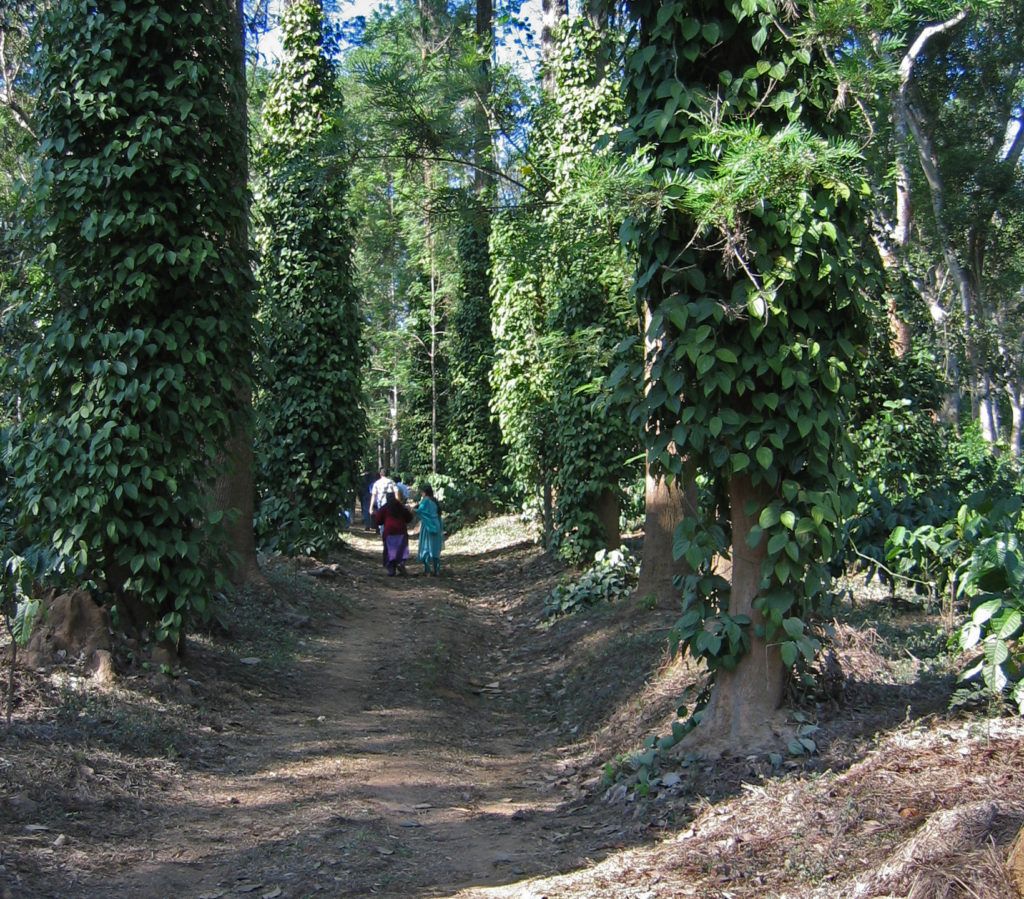
This is a road leading through coffee and pepper plantations in Karnataka, India. For elephants, it’s easy to mistake a plantation as just another part of the forest. Picture by Dcrjsr (Own work) CC BY 3.0, via Wikimedia Commons.
Many people have already died or been wounded. As Grant points out, in India elephants are venerated as gods closely related to Ganesha. However, after numerous altercations between elephants and humans on the coffee plantations, many have come to see elephants as violent.
“Workers won’t risk their lives to work if elephants are there,” Thomas explained. “They set off fire crackers and try to scare elephants away, but when they scare the elephants they merely scare them to a different estate.”
It’s because of this cyclical conflict that the Indian government called upon the Jenu Kuruba mahouts, people who care for and ride elephants, to capture and tend them.
Elephant camps have been the solution – but are they a good one?
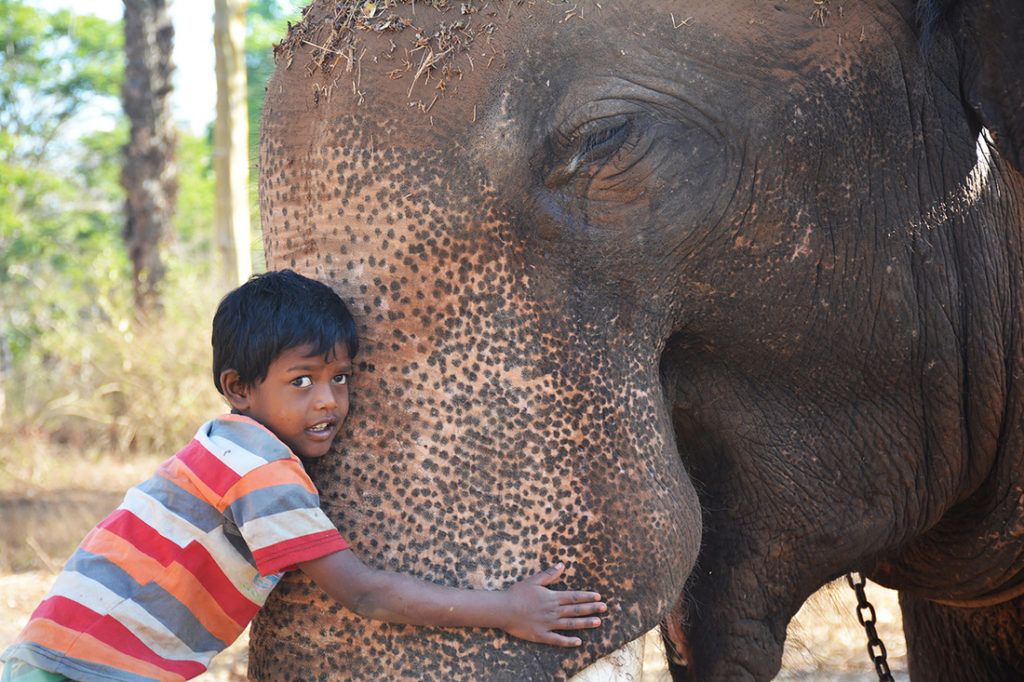
Children grow up around elephants and often form strong bonds with them. Picture courtesy of Elephants in the Coffee.
The situation in Karnataka and the Anechowkur Elephant Camp is unique. It is what originally attracted Grant to this project. He traveled to the camp for the first time in 2011 with a group of students studying abroad, with no plans to make a documentary. The aim was to develop an intercultural exchange through photography. The university students would work with local children to teach them how to use cameras, and in the process, they would learn more about the mahout culture and their historical interactions with elephants.
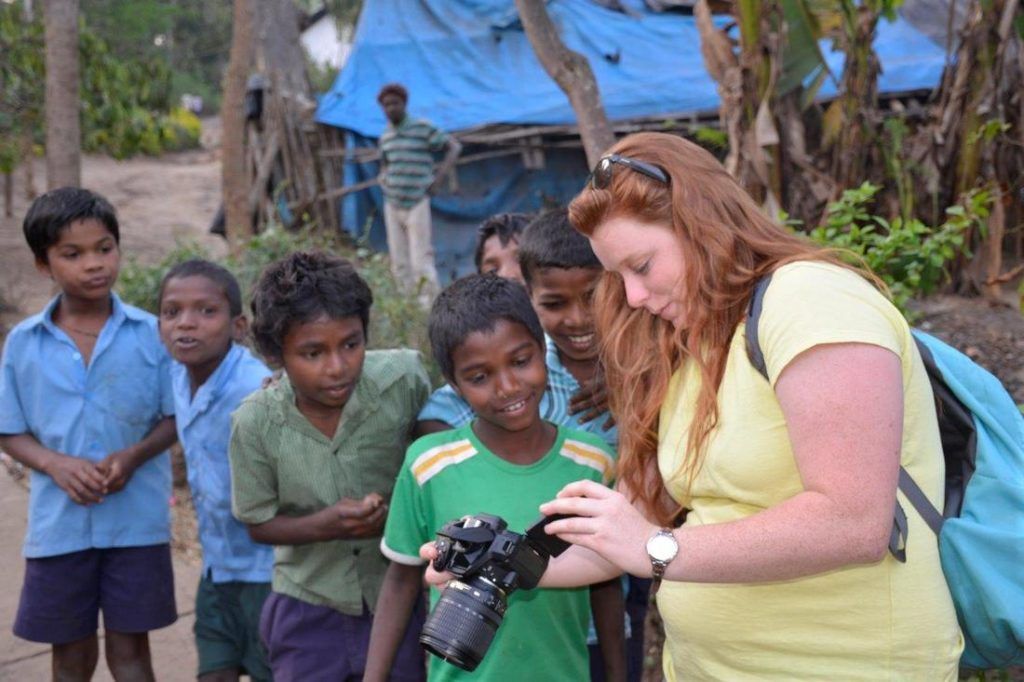
A university student shows children how to use a camera. Picture courtesy of Elephants in the Coffee.
However, Grant and his team were in for a big surprise. During their first trip, they saw 11 elephants at the camp. Two years later, the number had more than tripled to 35 elephants, some of which were in large, cramped, wooden cages.
“The elephant situation was so unusual. We didn’t expect to see the big cages there in the middle of the elephant camp,” he said, adding that the presence of so many elephants was also unexpected.
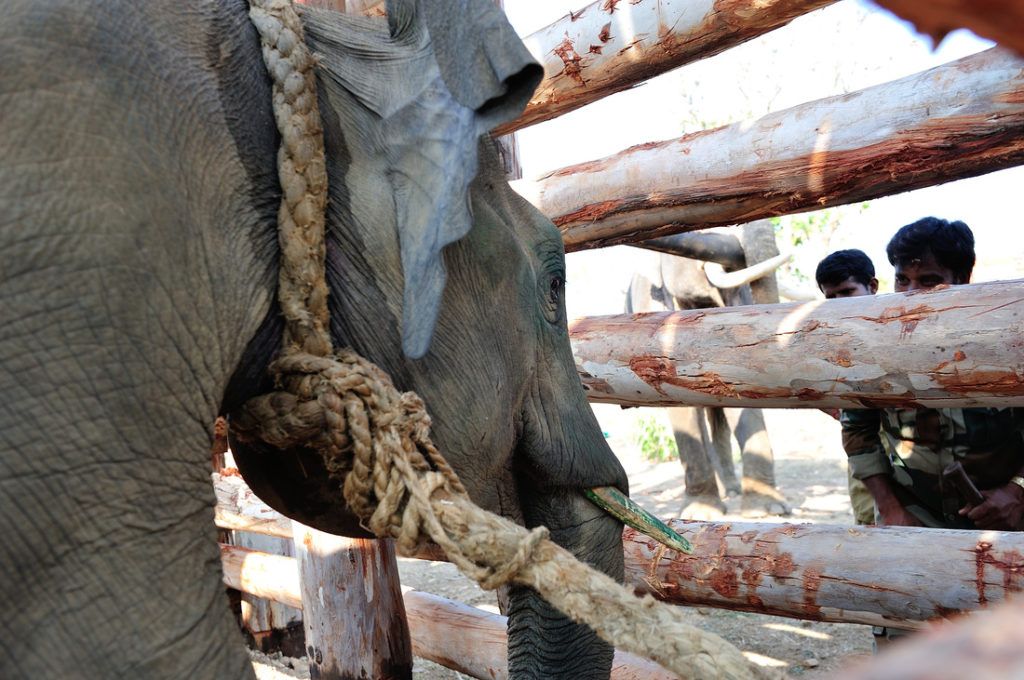
This elephant is a new arrival and will spend three months inside this wooden cage. Mahouts work with elephants that have lived in the camp for a longer time, using movements to direct the elephants to transport the logs and assemble the cage. Picture courtesy of Elephants in the Coffee.
Grant was so concerned by the situation that he and his students decided to create a documentary that explored the complex and often nuanced factors that force elephants into camps, and the difficult lives of the people who care for them.
Elephants live in captivity and are forced into a dependent relationship with their caregivers
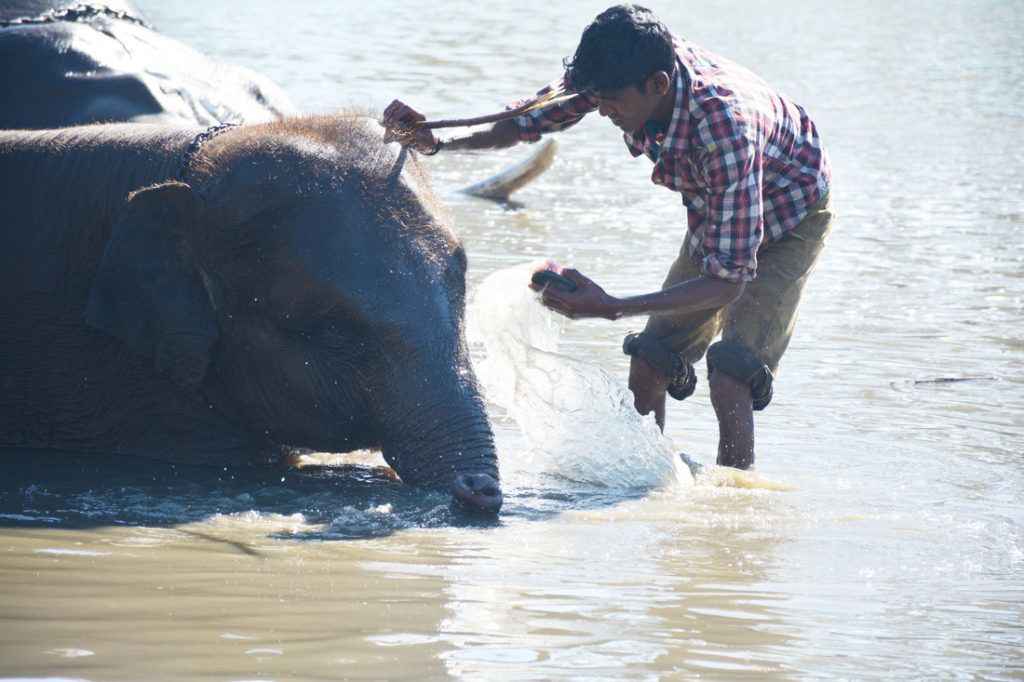
Elephants and their mahouts must develop a strong sense of trust in order to work together. Picture courtesy of Elephants in the Coffee.
When an elephant seems problematic to the coffee plantations, it is captured and sent to the elephant camps, where it will spend the rest of its life living with the mahouts.
Mahouts work directly with the elephants – they feed, bathe and clean up after them. Living and working in such close proximity to elephants is dangerous, so mahouts try to develop strong bonds with the large creatures. In order to train or bond the elephants, a number of controversial procedures are used.
First, the elephants are housed in a wooden cage for three months and effectively starved. It may be hard to understand, but Grant explained that the mahouts believe this period of containment tames the elephants and teaches them dependency.
“It is not a pretty picture,” said Grant as he described the elephants’ indoctrination to the camp structure. “I found that hard to take.”
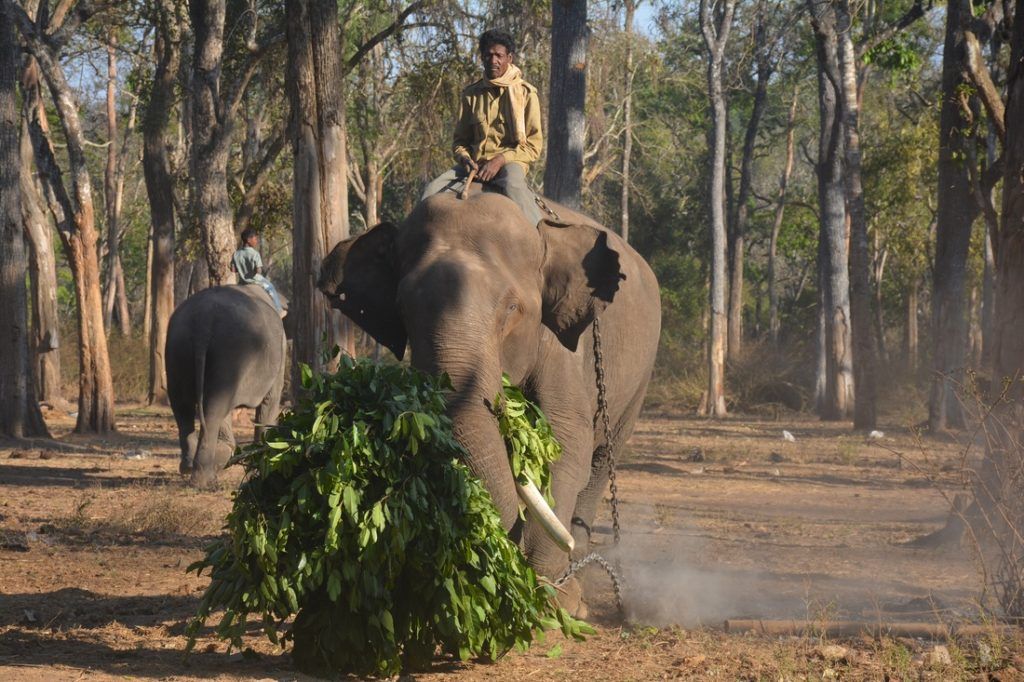
A Jenu Kuruba mahout rides one of the captured elephants. The elephants have eaten most of the nearby food, so provisions have to be transported into the Anechowkur camp. Picture courtesy of Elephants in the Coffee.
After the elephants develop a bond with their providers, they are allowed out from the cages but still wear chains. During the day, the mahouts care for them by bathing and feeding them. They live together and even share the same water sources. At night, they can roam the forests.
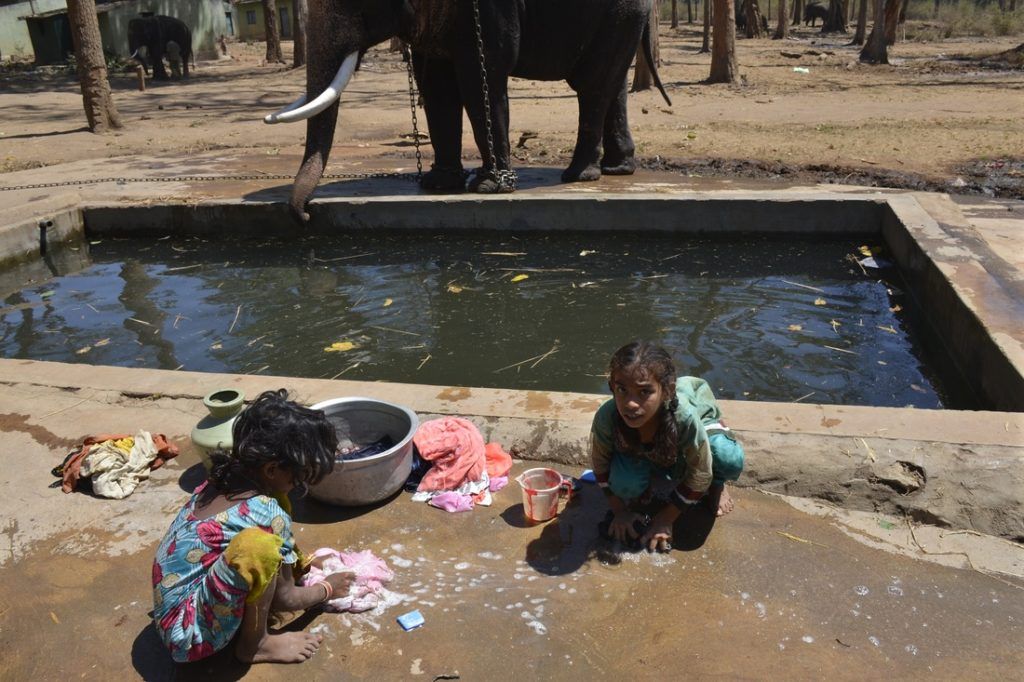
This is the only source of water for the elephants and the people in their villages, and they share it to wash clothes and dishes by hand. Picture courtesy of Elephants in the Coffee.
Despite the bond, good intentions and interlocked lives, the treatment is not always humane. The mahouts carry bull hooks and hit the elephants, treatment that has been repeatedly condemned. For the elephants, life in the camp is ultimately a life in captivity.
Mahouts share a precarious existence with the elephants, with little support from the government

Mahouts have small, government-issued homes with shared living spaces. When they start bonding a new elephant, they construct small tents close to the elephants’ cage. They believe that living closer to the elephant allows the animal to get used to the mahouts’ smell and better develop a bond. Picture courtesy of Elephants in the Coffee.
Seeing the mahouts directly interacting with and abusing the elephants, it might be tempting to place the blame squarely on them for the elephants’ problems. However, there are many factors at play that contribute to the poor conditions the elephants, and the mahouts, find themselves in. In many ways, the elephant camps highlight not only issues related to animal rights, but also social justice.
“The conditions are poor and they feel downtrodden,” Grant said, adding that mahouts not only live with inadequate resources, they also perform a very dangerous job by working with the elephants.
The government only pays the mahouts $125/month to care for the elephants. They live in small cabins with no running water or electricity in a relatively isolated area that makes access to education difficult. While there isn’t an excuse for mistreating animals, the limited resources and education don’t offer much incentive — or the necessary support — to properly care for the elephants in the first place.
“I am not sure anyone is asking, ‘Is this the best way to care for elephants?’” Grant said.
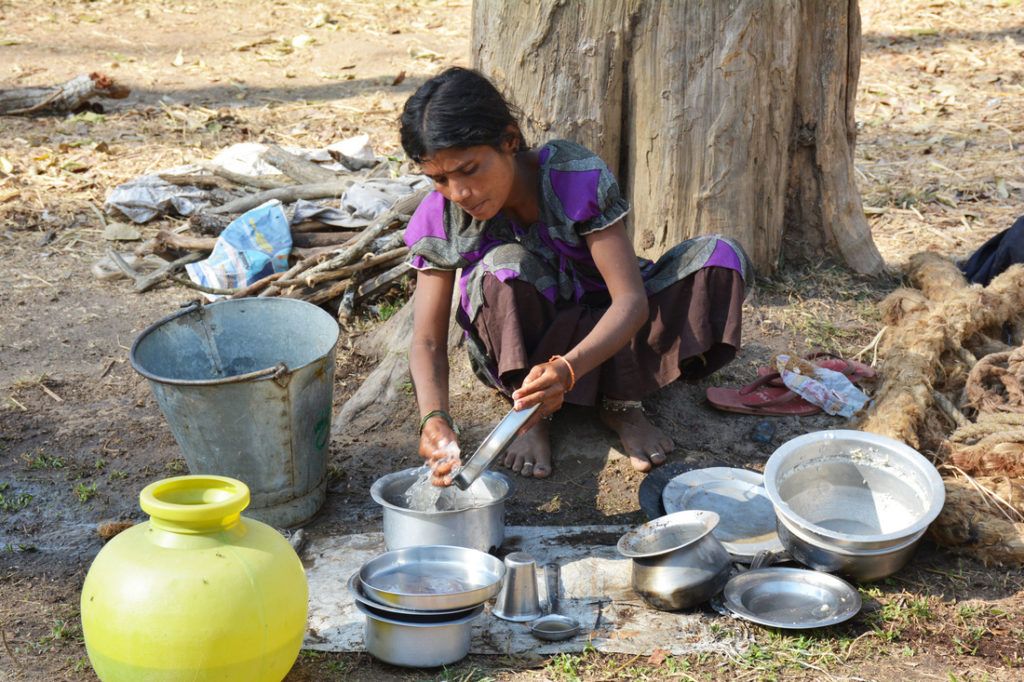
Women usually do the dishes by hand outside since the villagers do not have electricity or running water. Picture courtesy of Elephants in the Coffee.
The elephant camps do not seem like a long-term solution. Conflicts between elephants and coffee workers keep happening, and most would agree keeping elephants in captivity is not healthy for them or benefiting this endangered species. Luckily, there are some possible solutions to this complex problem.
Learning to live with elephants – alternatives to elephant camps
Right now, the situation is less than ideal. Elephants are still being sent to live in camps, but a few ideas are in the works to help both elephants and coffee planters live peacefully.
Building a fence around a national park may contain elephants and keep coffee workers safe
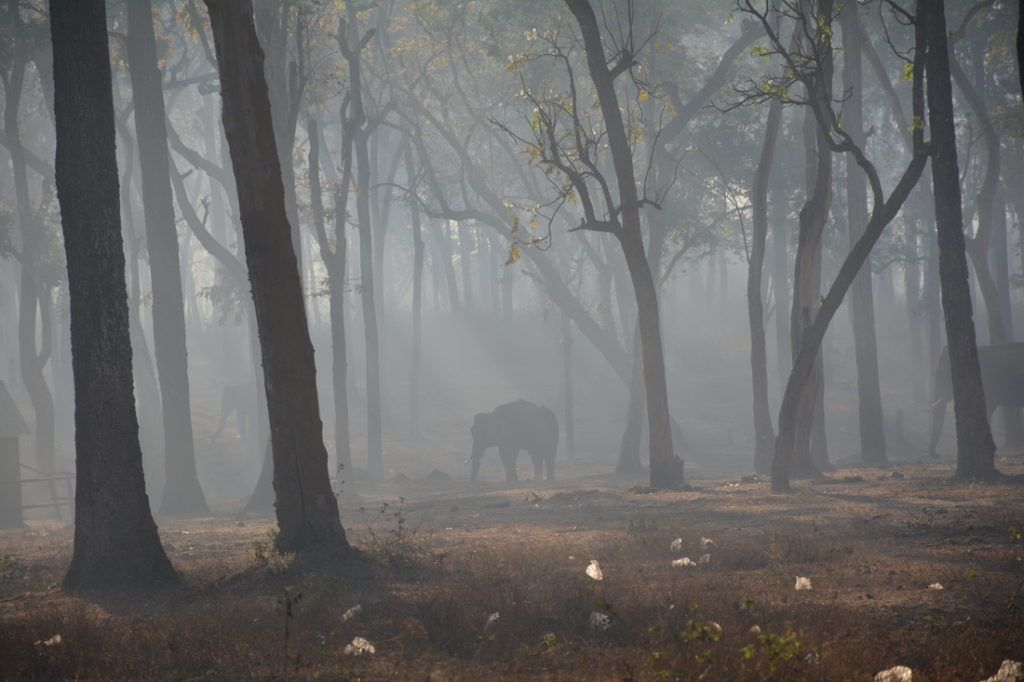
Mourning at the Anechowkur Elephant Camp. Picture courtesy of Elephants in the Coffee.
One idea that is already being carried out involves the nearby Nagarhole National Park. This is where the elephants are meant to live, but elephants like to roam far and wide.With their rich vegetation, coffee plantations look a lot like an extension of forest to the elephants. Most conflicts between coffee workers and elephants usually occur just a few miles outside the park’s boundaries, so one solution may be to build a fence around the park to keep elephants outside of the plantations.
“A fence around the park seems like a reasonable idea if indeed elephants lived and were contained in the park all the time, but elephants roam long distances,” Grant said, questioning the wisdom of a fence. “They’ve been restricted in their range to a relatively small part.”
For Grant, there may be a better solution.
“At this point, because they’ve been pushed back into these relatively small areas and they’re endangered, we have to look at it differently and not ask how can we stop them from leaving the park, but how can we coexist?”
Large coffee producers might have the solution to coexisting with India’s elephants

Workers on one of Tata’s large coffee estates. Picture by Philip Larson (Flickr) CC BY-SA 2.0, via Wikimedia Commons.
Some large coffee producers like Starbucks and Tata actually have fairly efficient ways of coexisting with elephants already. They employ people to watch out for elephants and have implemented a notification system to warn workers when elephants are around. When that happens, workers simply move to a safe, elephant-free area on the plantation.
“We think that Tata and Starbucks can be a leader in this area,” said Grant. “They have the most successful method we’ve seen of coexisting with elephants.”
Unfortunately, implementing this method on other coffee plantations in the region is more difficult. Most plantations are only 10 acres or less. Trying to find an area away from the danger of elephants on a plantation that small might be tricky. Ideally, Grant imagines a large group like Tata coordinating efforts to track elephants and work between plantations in the area. It is a large task, Grant admits, but large companies have more leverage and power to advocate for better solutions.
The Indian government needs to compensate workers for lost crops
Another way to encourage workers to coexist with elephants might be to implement a more efficient system of compensation for damaged crops. Compensation already exists, but the government is often very slow when it comes to processing claims and the compensation farmers do receive isn’t always enough.
“Tata seems to think – that was kind of surprising to us – the damage the elephant creates is not the huge problem. It’s the threat to people that’s the problem,” said Grant. “I think the farmers complain that the government doesn’t compensate them enough when the elephant comes in. On the other hand that’s a mechanism that could exist that would satisfy many farmers if they could protect their workers.”
Monitoring coffee plantations from above may help track elephant movement
Grant is also looking into a fourth option to help prevent conflicts between workers and elephants. Inspired by technology created to track crowd movements for security purposes, like those used at the Olympics in Rio, Grant imagines using surveillance or aerostat balloons to track elephants. However, this would be very expensive, and it still needs to be tested to see if it will work in forested areas.
Elephants in India face an uncertain future
Clearly, there are a lot of ideas to try to improve both elephants’ and workers’ lives, and Grant and his team also have a lot of respect for the way Indians are tackling this issue. But many of them seem daunting. All of these possible solutions require a lot of time, money, resources and commitment on the part of the community as well as the government.
Elephants in the Coffee plays an important role in raising awareness. “To me, this is one of those problems you look at and you think, my god, how can you solve it?” said Grant.







